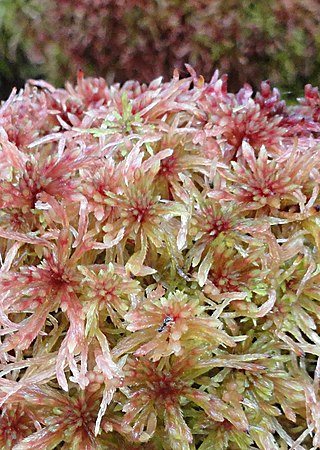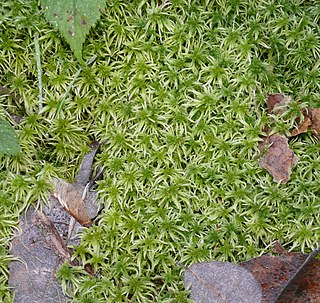Rhytidiadelphus triquetrus, the big shaggy-moss or rough goose neck moss, is a species of moss in the family Hylocomiaceae. It is often the dominating moss species in moderately rich forest habitats in the boreal regions and the Pacific Northwest. Because of its fuzzy appearance and tail-like shape it is also called the 'electrified cat's tail moss'. Not to be confused with square goose-necked moss, Rhytidiadelphus squarrosus.

Bryology is the branch of botany concerned with the scientific study of bryophytes. Bryologists are people who have an active interest in observing, recording, classifying or researching bryophytes. The field is often studied along with lichenology due to the similar appearance and ecological niche of the two organisms, even though bryophytes and lichens are not classified in the same kingdom.

Amblystegium serpens, also known as the creeping feathermoss or nano moss, is a species of moss. It is a common species in Britain.
Sphagnum affine, the imbricate bogmoss, is a species of peat moss or sphagnum moss which is exploited to make commercial peat products. This moss has a yellowish coloring.

Tetraphidaceae is a family of mosses. It includes only the two genera Tetraphis and Tetrodontium, each with two species. The defining feature of the family is the 4-toothed peristome.

Discelium is the only genus of moss in the family Disceliaceae; it contains the single species Discelium nudum, the flag-moss. This species is rare, but is widely distributed in cool and temperate climates of the Northern Hemisphere.

Physcomitrium pyriforme, commonly known as common bladder-moss, is a bryophyte native to all continents except South America and Antarctica. Its capsules mature beginning in late fall and through the spring. It is most commonly found in wet soils in disturbed locations. A highly variable species, size, leaf characters and shape of the capsule vary across its range, but often within populations as well.
Pohlia scotica, commonly known as Scottish threadmoss, is a moss endemic to Scotland. The earliest records date to 1964 and this moss was recognised as a distinct species in 1982. The largest populations are in Argyll with smaller populations in Dunbartonshire and Easter Ross. Its favoured habitat is silt, sand and gravel subject to regular inundation. The species has been provisionally classified as Lower Risk and receives protection under the Wildlife and Countryside Act 1981.
Bryum dixonii, commonly known as Dixon's threadmoss, is a moss endemic to Scotland. The species occupies montane habitats, and although rare it has a wide distribution including the central and north-west Highlands, and the islands of Skye, Rùm and St Kilda. Originally discovered on Ben Narnain, Argyll, in 1898 by Hugh N. Dixon, it was not seen again until 1964 when found by Ursula Duncan at Juanjorge in Glen Clova in Angus. As of 2000 there was no species action plan for its protection.
Didymodon mamillosus, commonly known as Perthshire beardmoss, is a species of moss endemic to Europe. It occurs at only five sites including one in Scotland where it is classified as "Critically Endangered". The other sites are in Iceland, Germany, the Czech Republic and in north-east Spain.

Plagiomnium medium, commonly known as Alpine thyme-moss or intermediate plagiomnium moss, is a moss found in montane habitats in the Northern Hemisphere.

Hypnum cupressiforme, the cypress-leaved plaitmoss or hypnum moss, is a common and widespread species of moss belonging to the genus Hypnum. It is found in all continents except Antarctica and occurs in a wide variety of habitats and climatic zones. It typically grows on tree trunks, logs, walls, rocks and other surfaces. It prefers acidic environments and is fairly tolerant of pollution. It was formerly used as a filling for pillows and mattresses; the association with sleep is the origin of the genus name Hypnum.

Sphagnum angustifolium, the fine bogmoss, is a species of peat moss with a Holarctic distribution.

Sphagnum russowii, Russow's sphagnum or Russow's bogmoss, is a species of peat moss with a Holarctic distribution.

Sphagnum girgensohnii, also known as Girgensohn's bogmoss, Girgensohn's sphagnum or common green peat moss, is a species of peat moss with a Holarctic and Indo-Malesian distribution.

Bartramia pomiformis, the common apple-moss, is a species of moss in the Bartramiaceae family. It is typically green or glaucous in hue, although sometimes it can appear yellowish. The stems extend from a half cm to 8 cm, with narrowly lanceolate to linear-lanceolate leaves 4 - 9 mm long. The leaves have a nerve and are toothed. They are curled when dry but stick out when moist.

Calliergon cordifolium is a species of moss in the Calliergonaceae family, commonly known as the calliergon moss or heart-leaved spearmoss. The species is abundant in the right habitat, and grows in marshes and wet woodland, especially woodland of alder (Alnus) or willow (Salix), as well as around streams, ditches and pools. The species grows in tufts among other moss species. Calliergon cordifolium requires a wet environment to grow, and often grows completely submerged in water. It typically prefers lowland, but has been recorded as high as 910 metres (1,000 yd) above sea level in Inverness, Scotland. The species has a circumpolar Boreo-temperate distribution. It is found throughout Europe. It has been recorded in north and central Asia, as well as Turkey and Japan, throughout North America and in New Zealand.
The British Bryological Society is an academic society dedicated to bryology, which encourages the study of bryophytes. It publishes the peer-reviewed Journal of Bryology.

Mnium stellare, the starry thyme-moss or stellar calcareous moss, is a moss species in the genus Mnium.

Rhizomnium punctatum, also called dotted thyme-moss, is a small species in the genus Rhizomnium.













